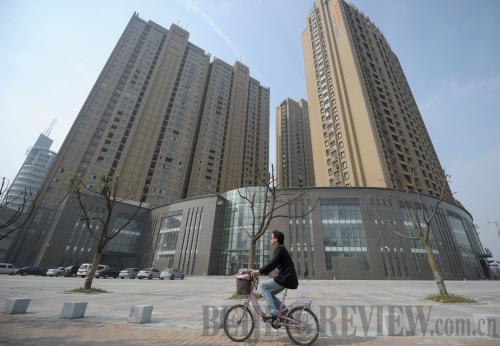|
 |
|
CALMING THE MARKET: A newly constructed complex stands tall in Hefei, capital of Anhui Province. Like many other Chinese cities, house prices in Hefei surged in the first quarter this year (GUO CHEN) |
The People's Bank of China, the central bank, on May 10 raised the deposit reserve requirement ratio for large commercial banks again—by 0.5 percentage points.
This is the third time this year the central bank raised the ratio, and is expected to freeze liquidity of more than 300 billion yuan ($44 billion).
After the adjustment, large financial institutions will be required to put 17 percent of their deposits on reserve, bringing the ratio ever closer to the peak of 17.5 percent in 2008.
Given the buoyant growth in the first quarter, China is showing signs of overheating, said Li Daokui, an advisor to the central bank's monetary policy committee and Director of the Center for China in the World Economy at Tsinghua University. Curbing excessive liquidity and calming down the overheated economy has since become regulators' priority, said Li.
The Chinese economy grew a robust 11.9 percent in the first quarter, accelerating from 10.7 percent in the last quarter of 2009.
Liu Yuhui, a senior researcher at the Chinese Academy of Social Sciences, told Xinhua News Agency that the economy is growing at a faster-than-expected rate, allowing asset bubbles to form.
To prevent a dangerous bubble bust, tightening monetary policies and mopping up excess liquidity have become urgent tasks, said Liu.
Guo Tianyong, Director of the Institute of China's Banking Industry at the Central University of Finance and Economics, said the liquidity management will continue throughout this year to offset the impact of the significant lending spree in 2009.
Siphoning excess liquidity
The central bank's intention is to control the liquidity increase and slow down money supply to maintain stable economic growth and ease the pressures of price hikes and price expectations, said Zhao Xijun, Deputy Director of the Institute of Finance and Securities at Renmin University of China.
Bank lending in the first quarter saw rapid growth. Central bank figures show that new renminbi loans totaled 2.6 trillion yuan ($380.67 billion) in the first quarter. If such growth continues throughout the rest of the year, total loans in 2010 would far exceed the government-set target of 7.5 trillion yuan ($1.1 trillion).
By the end of March, the broad money supply (M2) grew at 22.5 percent year on year—still higher than the normal speed of 17 percent, though the index had slowed for four consecutive months since the end of December 2009.
Moreover, the renminbi counterpart of foreign exchange reserves increased 749.1 billion yuan ($109.68 billion), 2.1 times the added amount as the same period last year. The ratio hike is closely related to the surging counterpart funds, said Lian Ping, chief economist of the Bank of Communications Co. Ltd.
Lu Zhengwei, chief economist at Industrial Bank Co. Ltd., agreed with Lian. The central bank wants to offset money supply increases in circulation brought about by foreign exchange inflows, including the trade surplus, foreign direct investment and international hot money, Lu said. Hot money, in particular, is pouring in, leveraging a risk-free source of profit from an expected rise in the Chinese currency, added Lu.
| 